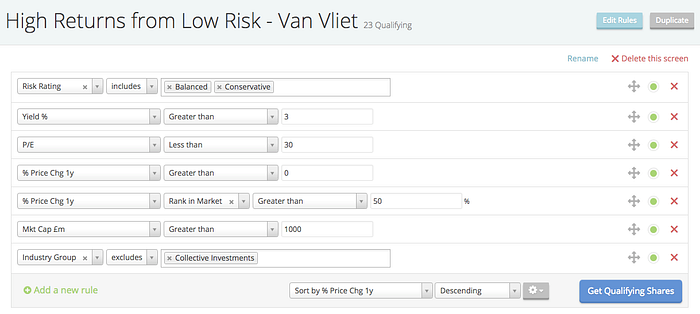High Returns from Low Risk — Van Vliet
A book review and recommendation

One of Europe’s most influential fund managers has written a fabulous little book titled “High Returns from Low Risk — a remarkable stock market paradox”. I don’t recommend many books, but I think there are a lot of investors that could learn from this. It’s barely 140 pages long, and in spite of a dose of marketing towards the end, it’s a great addition to any stock market investor’s library.
The book is written by academic-turned-fund manager Pim Van Vliet and his colleague Jan de Koning. Both work at the Dutch fund management group Robeco, which has become well known for its factor investing funds. While Van Vliet will take the plaudits for the book, it’s clear that De Koning has had a huge hand in making his ideas accessible and should take a lot of credit. It’s no mean feat to make tricky financial concepts easily understandable, and I think they’ve nailed it.

I’ve been reading Van Vliet’s academic research on Low Risk investing for years. In fact, his work was one of the biggest influences on our design of the RiskRatings recently launched on the Stockopedia website for more than 40,000 stocks worldwide. For those that know nothing about Low Risk investing and want a quick primer do read my previous blog on the topic.
The Tortoise & The Hare
In a nutshell, most investors believe that to achieve higher returns you need to take on higher risk. In fact, this is now so taken for granted that you’ll find risk vs return ‘sliders’ on practically all robo-advisory websites. Here’s what you’ll find on Nutmeg:

The message from the industry is… no risk / no return !
Van Vliet illustrates clearly with more than 86 year’s of stock market data that this is nonsense. Within the stock market universe, low risk stocks outperform high risk stocks dramatically over the long term.
They don’t do it every year. In fact high risk shares do outperform in bull markets. But low risk shares outperform to such an extent in bear markets and sideways markets that their overall ‘full cycle’ performance smashes that of high risk shares.
Van Vliet shows that from a universe of the 1000 largest US stocks, buying the…
Van Vliet shows that from a universe of the 1000 largest US stocks, buying the 100 lowest volatility (lowest risk) stocks and rebalancing the portfolio quarterly returned 10.2% annually versus 6.4% for the highest volatility stocks. This becomes quite a difference in portfolio size over the decades.

Van Vliet illustrates with the analogy of the Tortoise and the Hare. The high risk Hare keeps taking a nap while the Tortoise takes the line honours.
This message is particularly worth stressing right now as we’re entering a very speculative phase for the stock market. High risk shares have been going gangbusters but the party won’t last forever. Holding conservative shares at the core of a portfolio makes a lot of sense — it might help minimise any downside.
Our own RiskRating performance history (while not spanning 86 years) adds further third party evidence to Van Vliet’s low risk thesis.
Amping up Low Risk Returns with Income & Momentum
Of course, like all good quants, Van Vliet isn’t satisfied with 10.2% per year. He wants more. And this is where it gets more interesting, and where Van Vliet mirrors some more of the work we do at Stockopedia. He goes multi-factor.
- First up, he takes the 1000 largest US stocks and ranks them by volatility. He then discards the 50% highest risk (highest volatility) from the set.
- He then ranks the remaining stocks simultaneously for the size of their Dividend Yield (income), and the performance of their 1 year share prices (momentum).
- He buys the top ranked 100.
With this more advanced strategy he amps up the returns to 15% annualised over 86 years. And during these 86 years there isn’t a single decade that sees losses. Quite impressive. The key message is that using Momentum, as well as Low Risk, in portfolio construction ensures that there is enough participation in bull markets, as well as downside protection in bear markets.
Portfolios for Private Investors
Van Vliet is a fund manager, but he makes it clear that private investors are often best placed to profit from the low risk anomaly directly. I quote:
“When I started developing this strategy, I actually thought it would be of most interest to clients managing their own portfolios. People like my father, who have never looked at benchmarks, but who care about increasing and protecting their capital.”
He then dedicates an entire chapter to illustrating how private investors can find low risk stocks using a stock screener. Stockopedia is one of the sites recommended by Van Vliet on the website that accompanies the book so I thought I’d illustrate how you can implement his strategy using the screener here.
Van Vliet prefers to use Total Volatility than Beta for finding low risk shares. We’ve our own “% 1y Volatility” measure in the screener which is an annualised measure of the last three years of price history for every stock in our coverage.
But we’ve also turned this measure into the RiskRatings — an even easier filter. By filtering for “Conservative” and “Balanced” shares you can keep the 75% riskiest shares in the market out of your results.
In this screen — High Returns from Low Risk — Van Vliet — I’ve added filters as recommended for higher yield shares (yield > 3%) and higher momentum shares by their 1 year price strength as well as keeping the PE below 30 and removing collective investments. I’ve lowered his market cap cutoff to £500m to ensure more results.

For these rules there are 31 stocks that qualify in the UK, 78 in the US, 61 in Australia, 131 in Asia and 137 across Europe. The UK results do seem to be quite skewed towards financials, and I find much better average StockRanks for the shares listed in other markets. For Low Risk Investing taking a global approach can really help and ensuring sector diversification is key.
You can duplicate the screen and create your own by clicking this link.
To Conclude
There is much to like in Van Vliets book — his message is clear. Win by not losing. It’s a patient approach that most investors would be wise to put in practice, but which I’m sure most will ignore. The reality is that investors just can’t help themselves and end up losing money in the risky end of the market !
Hardcore data-driven investors may be disappointed that there are no appendices providing more detail into the parameters that created his results, but to give the authors credit they have created a website that offers a big Excel table for download here.
There are very few stock market investment books written in plain English for the layman. And of those that are, there are only a few worth reading. Wiley seems to have a knack for publishing these easy, informative reads. It’s a worthy addition to any stock picker’s library and one of few good reads on the Low Risk Anomaly. You can find it on Amazon here.
Written by Edward Croft, CEO at Stockopedia
Originally published at www.stockopedia.com.
Disclaimer: This content should be used for educational & informational purposes only. We do not provide investment advice, recommendations or views as to whether an investment or strategy is suited to the investment needs of a specific individual. You should make your own decisions and seek independent professional advice before doing so. Remember: Shares can go down as well as up. Past performance is not a guide to future performance & investors may not get back the amount invested.








